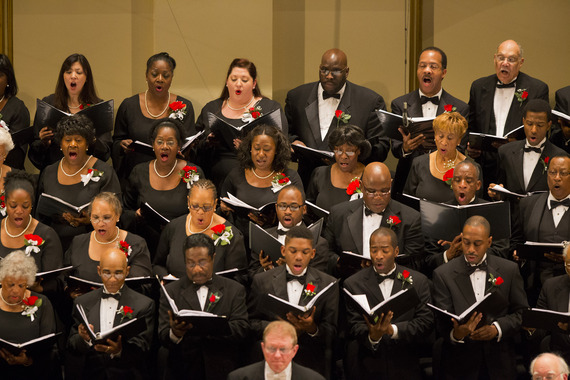
St. Louis Symphony Associate Concertmaster Heidi Harris and Principal Double Bass Erik Harris performing at Washington Metropolitan Church, part of the IN UNISON program. Photo courtesy of St. Louis Symphony.
On Monday night, demonstrators protested the Metropolitan Opera for performing John Adams' "The Death of Klinghoffer." Three weeks ago a very different kind of demonstration was held in Powell Symphony Hall. Just before the start of a performance by the St. Louis Symphony Orchestra and Chorus of the Brahms German Requiem, demonstrators unfurled banners reading "Requiem for Michael Brown" and "Racism Lives Here" above a drawing of the iconic Saint Louis Arch. Next the protesters sang several choruses of "Which Side Are You On," a 1930s protest song dating back to the bitter miners' strike in Harlan County, KY. It was all over in three minutes. The demonstrators departed peacefully, on their own volition, chanting "Black Lives Matter," and the scheduled performance proceeded.
What happened in those three minutes and what does it mean that it occurred in Powell Symphony Hall? Anyone who watched the video or heard the radio broadcast can see for themselves the confusion, fear, support, and anger the demonstrators inspired in the audience and on the stage. A full range of views and feelings is on display. The explosive and divisive issue of race with all its messiness, emotion, and frustration, had entered the concert hall. Whether orchestras are seeking a place in the country's continuing conversation about race, or that conversation descends on them, race is an inescapable fact of life for orchestras as it is in the rest of America. Orchestras have a long way to go to achieve racial diversity in the board room, onstage, and in the audience. But they are not standing still.
The Brahms Requiem is one of the most sublime expressions of loss, healing, and redemption. The demonstration organizers report that they carefully chose the occasion of its performance as the time and place to engage -- a testament to this canonic work's relevance and enduring capacity to take on new meaning as the context around it changes. Admittedly, the St. Louis Symphony did not choose this new context; it chose them. But the choice of time and place was an affirmation that the St. Louis Symphony and the Brahms Requiem matter, especially, as this simmering city confronts the most urgent issues triggered by the Michael Brown shooting.
This was not the St. Louis Symphony's first connection to Ferguson. Last month the orchestra participated in a concert in a Ferguson church in support of the community. The concert, billed as "Heal Ferguson," was organized by Brian Owens, St. Louis Symphony staff member and a Ferguson resident.
The concert was not a one-off gesture from the St. Louis Symphony. Its origins go back to 1992 when the St. Louis Symphony acknowledged both its challenges around racial diversity as well as the incredible opportunity in making music together with the choral talent resident in Saint Louis' African-American churches.
The SLSO built a relationship with more than forty African-American churches that remains a robust collaboration including a 120-member chorus recruited from the church choirs that performs two times per season with the orchestra in Powell Hall and once in a free community concert at a partner church, and performances by SLSO musicians in twenty churches annually.
The St. Louis Symphony performance in Ferguson reminds me of a story relayed by director Peter Sellars in his keynote to over a thousand delegates to the National Conference of the League of American Orchestras in LA in 2006:
We arrived at this church on a Saturday afternoon, and it was in the middle of a full gang funeral for a young man the community valued who'd been shot in gang crossfire. And the church was filled with mourners and a kind of heaviness over the pointless violence that's going on right now in our cities -- this sense of losing the best of a generation. In certain neighborhoods, you do not expect, if you're a young man, to live past the age of 25. The orchestra had programmed the Egmont Overture of Beethoven. Those opening chords in that grief-stricken community were overwhelming... That Saturday afternoon is my most important experience of Beethoven in my whole life. And it needed the audience to teach me what Beethoven was trying to express.
Issues of race and repertoire have been making dramatic and widely observed appearances in orchestras lately. In June, the rapper Sir Mix-A-Lot, in a performance with the Seattle Symphony Orchestra and a group of spontaneously assembled women from the audience, sparked vitriolic debates about race and gender when a video of the performance went viral.
Aaron Flagg, Professor of Music and Dean, The Hartt School, and board member of the League of American Orchestras and Stamford Symphony, offers a thoughtful reflection on the event in the current issue of Symphony Magazine.
The performances mentioned here, and dozens of others across the country, demonstrate orchestras' growing awareness of the civic and creative possibilities that result from crossing the racial divide, the power of the orchestral experience to unite, and ultimately, the relevance of the art form to critical issues of our time.
